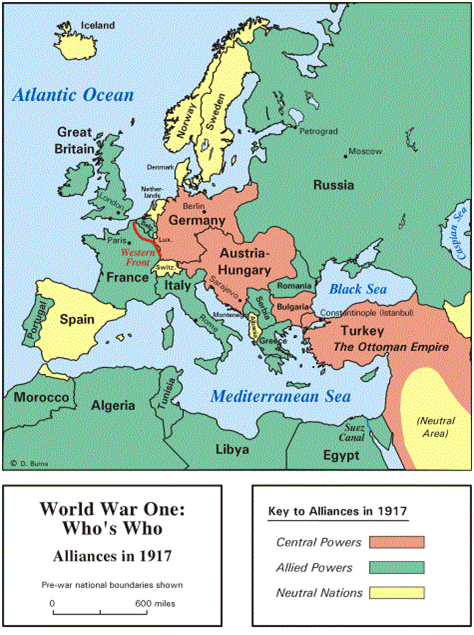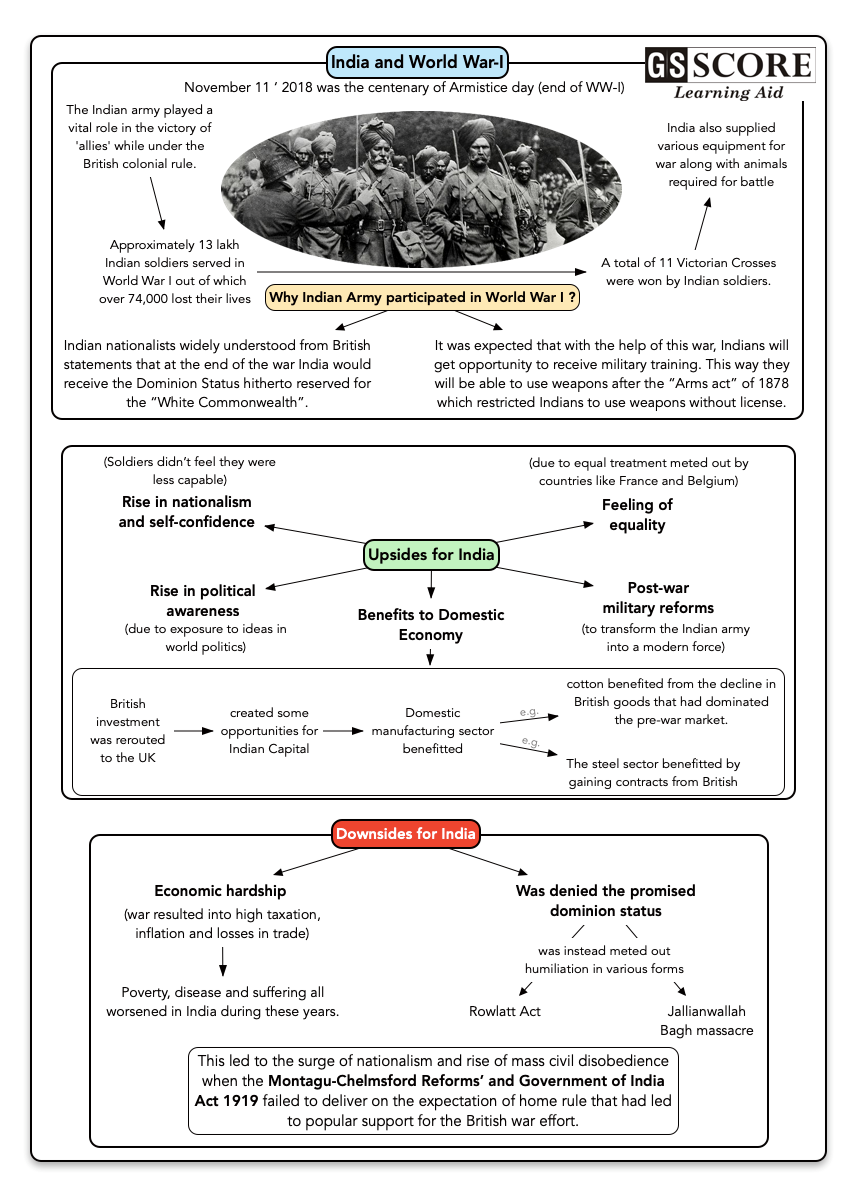

November 11 is the centenary of Armistice Day– a memorial day observed in Commonwealth of Nations member states since the end of the war.
Issue
Context:
- November 11 is the centenary of Armistice Day– a memorial day observed in Commonwealth of Nations member states since the end of the war.
- Vice President of India M. Venkaiah Naidu inaugurated the first India-built war memorial in northern France at the Armistice of World War I centenary commemoration to pay tribute to thousands of Indian soldiers who fought and made sacrifices during the World War I.
Background
World War 1
- It was one of the greatest watersheds of the 20th century geopolitical history. While the war was contained to the period from 1914 to 1918, it continued to define the status of world politics until the Second World War.
- It entangled almost all of Europe, the Middle East, and Russia, and from 1917, also the United States of America.
- The 'central powers' entailing Germany, Austria-Hungary and Turkey (the Ottoman Empire) were defeated against the 'allies' France, Great Britain, Russia, Italy, Japan and United States.
- World War I ended on November 11, 1918 at the 11th hour of the 11th day of the 11th month. This day marks 100 years of the Great War ending.
- The Treaty of Versailles signed on June 28, 1919, officially put an end to World War I.
- World War I ended the first era of globalization. It was followed by three decades of economic misery thanks to the collapse of global trade, a rising tide of protectionism and deep recessions in several countries.
- The balance of global economic power began to shift as the US and Japan made a deeper impact on the world economy.

Analysis
Role of India in World War 1:
- Approximately 13 lakh Indian soldiers served in World War I out of which over 74,000 lost their lives.
- Indian Army served in France, Belgium, Egypt, Mesopotamia, Gallipoli, Sinai among other locations
- India also supplied various equipment for war along with animals required for battle.
- The Indian Army fought the German Empire on the Western Front and German East Africa (a German colony in the African Great Lakes region). The Western Front became the main theatre of WWI when it was opened by Germany by invading Luxembourg and Belgium which bordered France.
- Khudadad Khan became the first Indian to be awarded a Victoria Cross. He was a machine gunner with the 129th Baluchi Regiment. A total of 11 Victorian Crosses were won by Indian soldiers. Others are Mir Dast, Shahamad Khan, Lala, Darwan Negi, Gabbar Negi, Karanbahadur Rana, Badlu Singh, Chatta Singh, Gobind Singh and Kulbir Thapa.
- The army played a vital role in the victory of 'allies' while India was under the British colonial rule. It provided in large numbers and distinctly to the European, Mediterranean and the Middle East halls of war.
- The New York Times in 1918 wrote, "The world must pay India in whatever India wants, for without Indian products, there would be greater difficulty in winning the war." An estimated 12 lakh horses and mules were used by Britain during World War I. It is believed, the animals India provided were the finest and this proved to be a game changer during the war.
Experiences of Indian army:
- Soldiers of France and Belgium welcomed Indian army. Soldiers who were wounded got good treatment and care in these countries which sensitized them about unfair treatment meted to them by Britishers.
- They fought alongside Britishers and French army against strong German soldiers for which their performance was appreciated and they received medals like Victoria Crosses.
- They participated in various difficult situations like extreme winters of Europe, trench wars and more.
- The Indian contingent was a multi-ethnic, multilingual and multi religious forces consisting semi or non-literate people. This means that there aren’t many diaries, poems and memoirs, but traces of their war experience is scattered across the libraries, archives and private collections.
Why Indian Army participated in World War 1?
- As British became part of World War 1 so the Government of India which was under Britishers automatically became part of it. Indian army was also known as Imperial Strategic Reserve as it supplied massive manpower to the allied forces.
- All political leadership of world wanted Indians to participate in World War in maximum number.
- Indian nationalists did not seek to take advantage of Britain’s vulnerability by inciting rebellions, or even disturbances, against the Empire. Because nationalists widely understood from British statements that at the end of the war India would receive the Dominion Status hitherto reserved for the “White Commonwealth”. Instead, Indians rallied to the British cause:
- There were no mutinies against the British, though political unrest did continue in Punjab and Bengal.
- Mahatma Gandhi launched the Champaran Satyagraha in 1917 in defence of farmers forced to grow indigo, and the Kheda satyagraha, against iniquitous taxes in Gujarat, , but both were protests against specific iniquities and not yet a mass movement against the Empire as a whole.
- Mahatma Gandhi, who returned to his homeland from South Africa in January 1915, supported the war, as he had supported the British in the Boer War.
- It was expected that with the help of this war, Indians will get opportunity to receive military training. This way they will be able to use weapons after the “Arms act” of 1878 which restricted Indians to use weapons without license.
- Masculine nationalism hence will strengthen Indians to stand against powerful Britishers.
Impact of World War 1 on Indian Army:
- Indian nationalism: Fighting in Europe, Egypt, Mesopotamia and others, they developed a sense of belongingness and Indian nationalism in world scenario. Example Punjab—which supplied a large proportion of the troops thanks to the British martial races theory—turned into an epicentre of nationalism after the war.
- Self-confidence: They overcame the feeling of being backward civilization, illiterate and less capable as was given in oriental concept by their performance in war field.
- Feeling of equality: They were given humane treatment by people of other countries like France and Belgium.
- Politicisation of Indian Army: The army which returned after World War 1 was more nationalistic, much more aware of world politics and had better training in weapons and modern technologies.
- Soldiers writing home warned others not to join up. As the war dragged on, casualties mounted and recruitment methods grew more coercive, resentment grew
- Post-war military reforms to transform the Indian army into a modern force started a process that accelerated with the onset of World War II.
Impact of World War 1 on India:
Downsides:
- India was wrecked by high taxation – and the high inflation accompanying it – to support the war, while the disruption of trade caused by the conflict led to widespread economic losses.
- All this while the country was reeling from a raging influenza pandemic – the 1918-19 Spanish flu was the most devastating in history, with estimates of global mortality ranging from 20 to 50 million, and the focal point of the pandemic was India, with an estimated death toll of between 10 and 20 million.
- Poverty, disease and suffering all worsened in India during these years.
- The drain on the Indian economy in the form of cash, kind and loans to the British government came to about 367 million pounds.
Upsides:
- Domestic manufacturing sectors such as cotton benefited from the decline in British goods that had dominated the pre-war market.
- The steel sector so crucial after independence benefited as well. For instance, the ailing Tata steel mills were handed a lifeline in the form of a contract to supply rails to the Mesopotamian campaign.
- British investment was rerouted to the UK, creating opportunities for Indian capital. The war economy boosted Indian capitalism in some ways.
India’s expectation in return of their contribution:
- At that time, India gifted as high as 100 million British Pounds (Rs 893 crore) to Britain to fund their war in hope of dominion status and home rule in return.
- India also supplied as much as 37 lakh tonnes of supplies to the British.
- However, India was denied its promise of dominion status after the war ended.
- Instead, the country was 'awarded' Rowlatt Act (The Anarchial and Revolutionary Crimes Act of 1919) that effectively authorized the British government to imprison any suspected person for up to two years without a trial.
- Public protests against this draconian legislation were quelled ruthlessly. The worst incident was the Jallianwallah Bagh massacre of April 1919, when General Dyer ordered his troops to fire without warning on 15,000 unarmed and non-violent men, women and children demonstrating peacefully in an enclosed garden in Amritsar, killing as many as 1,499 and wounding up to 1,137.
- Dyer was hailed as a hero by the British which marked the final rupture between British imperialism and its Indian subjects. Sir Rabindranath Tagore returned his knighthood to the British in protest against “the helplessness of our position as British subjects in India”.
- This led to the surge of nationalism and rise of mass civil disobedience when the Montagu-Chelmsford Reforms’ and Government of India Act 1919 failed to deliver on the expectation of home rule that had led to popular support for the British war effort.
Conclusion:
When the world commemorated the 50th anniversary of the First World War in 1964, there was scarcely a mention of India’s soldiers anywhere, least of all in India. The general feeling was that India, then freshly freed from the imperial yoke, was ashamed of its soldiers’ participation in a colonial war and saw nothing to celebrate.
The British, however, went ahead and commemorated the war by constructing the triumphal arch known as India Gate in New Delhi. Built in 1931, India Gate is a popular monument that commemorates the Indian soldiers who lost their lives fighting in the war.
Learning Aid
Practice Question:
Approximately 1.3 million Indian soldiers served in World War One, and over 74,000 of them lost their lives. But history has mostly forgotten these sacrifices, which were rewarded with broken promises of Indian independence from the British government. Critically analyse the statement in the light of centenary celebration of end of First World War.


